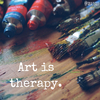The MAS - Form Over Substance
ANTWERP, BELGIUM – Located in a ten-story building in the port of Antwerp, the MAS (Museum aan de stroom, which means as much as museum by the riverside) has rapidly become one of Belgium’s most notable landmarks. The museum, a design by Dutch architects Willem Jan Neutelings and Michiel Riedijk, opened its doors in May 2011 and contains over 470,000 exhibits exploring the rich history and future of the city of Antwerp.
Without discussing matters of taste, it has to be said that the MAS is a striking piece of architecture: with its huge glass windows and panorama terrace, it offers a great view over the city and the whole dockside area (as seen in photos 1 - 2). Just be careful to go up the rooftop in cold and windy weather because it takes only 2 minutes up there to freeze your butt off.
But that’s enough talking about the building. In the end we all know it is the inside that counts (as seen in photos 3 – 5). The exhibitions are thematically arranged floor by floor. Next to the museum’s main collection, there is always a temporary exhibition which can be visited separately. The tour starts off with the Visible Storage collection. Pieces from various collectors that would normally be kept in storage can be seen by the public in what looks like a well-designed D.I.Y store. The room gives you the feeling to be hovering in your grandmother’s attic in the hope to find a handwritten love letter from Ernest Hemingway. I didn’t find the latter but there were some nice Maria statues.
Another two-story exhibition covers the thoughts on life and death in different cultures. The collection itself is interesting but not really that world-shaking. One nice aspect is the red thread running throughout the entire museum. The thread is used to interact with the public, people can tie a knot in a red or white rope to indicate if they believe in life after death or not. The Display of Power exhibition focuses on the meaning of power and what symbols it has and had all over the world.
The history and future of Antwerp is brought to the public’s attention in the two remaining expo´s. One of them is called “World Port” and gives an overview of the trading and shipping through the last centuries. The other one, “Metropolis” shows us various sides of Antwerp, ranging from puppet theaters to the Kasena people of northern Ghana.
The last thing that can be said about the MAS, is that it seems that the design aspect dominates. It is indeed nice to try something different and make an ethnological museum “cool and hip” but so far, it is difficult to look pass the surroundings and really see the collection for what it is.
Photo credits
Photos 1 - 2: courtesy of Filip Dujardin
Photos 3 - 5: courtesy of Coby Hounjet












